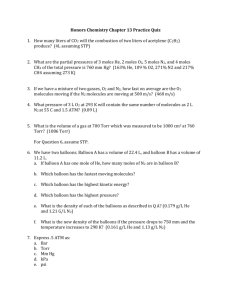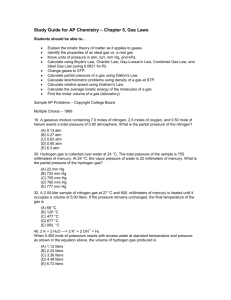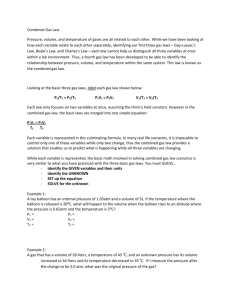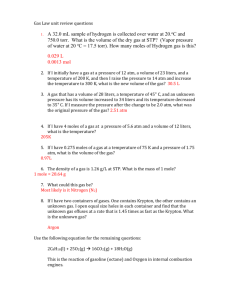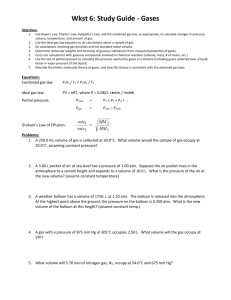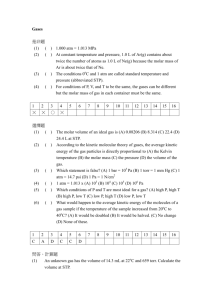Gas Laws - Alliance Gertz
advertisement
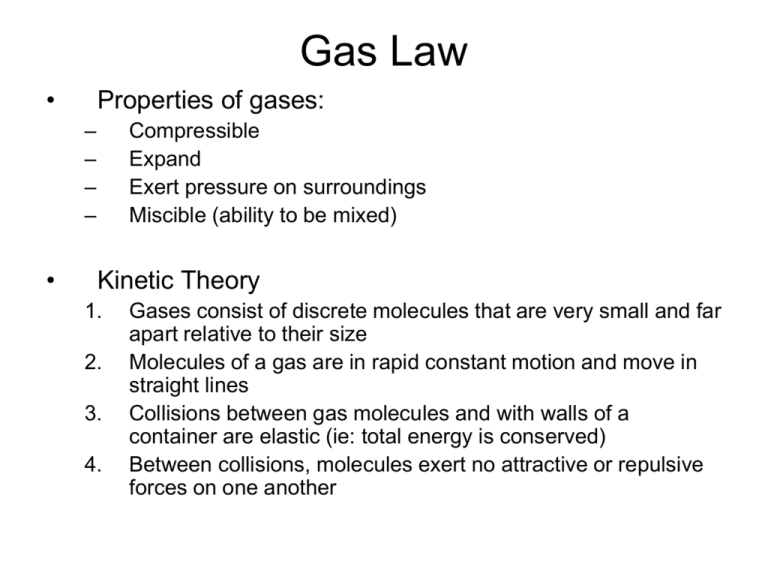
Gas Law • Properties of gases: – – – – • Compressible Expand Exert pressure on surroundings Miscible (ability to be mixed) Kinetic Theory 1. 2. 3. 4. Gases consist of discrete molecules that are very small and far apart relative to their size Molecules of a gas are in rapid constant motion and move in straight lines Collisions between gas molecules and with walls of a container are elastic (ie: total energy is conserved) Between collisions, molecules exert no attractive or repulsive forces on one another Diffusion • Gas molecules are constantly, randomly moving. • Over time, gas particles will tend to move and try to take up as much space as possible, mixing with other gas molecules easily. • Gas molecules will naturally try to move from higher concentrations to lower concentrations • This property of gases is known as diffusion. Gas Laws • Useful variables: – Pressure (P) – Defined as the force per unit area. Gases exert pressure because the molecules hit the surface of a container. – Volume (V) – the amount of space that is occupied by a gas. Standard unit is Liter (L), but cubic meters (m3), and other units are often used – Temperature (T) – the actual definition of temperature is the measure of the average kinetic energy of the particles in a sample of matter. – Mole (n) – the total number of moles of a gas present in a system. Pressure Conversion • There are a wide range of measurement styles used for pressure. All are common, but in the ideal gas law, only atmosphere is used. 1atm= 760 mmHg = 760 torr = 101.325 kPa = 1.01 x 105 Pa = 14.7 psi Kelvin Temperature • Temperature is measured using a variety of units, degrees Fahrenheit, degrees Celsius, and Kelvin. In the ideal gas law, only Kelvins are used TKelvin = TCelsius + 273.15 Standard Temperature and Pressure • Also known as STP • To make things easier, many experiments and calculations are performed at pre-set conditions of pressure and temperature • At STP, the standard pressure is 1 atm. • At STP, the standard temperature is 273K Gas Law • Boyle’s Law states that for a given amount of gas at a constant temperature, the volume of a gas varies inversely with it’s pressure. P1V1 = P2V2 Ex 1: A 15 liter sample of gas at 1.0 atm is compressed to 8.0 liters. What is the final pressure? Ex 2: A sample of gas held at 10 liters and 3.0 atm is allowed to expand and has a final pressure of 1.0 atm. What is the final volume of the gas? Gas Law • Charles’ Law states that the volume of a gas at constant pressure is directly proportional to the temperature. V1/T1 = V2/T2 Ex1: A balloon has a volume of 0.75 L. The balloon is taken to a new room where the temperature is 20oC. The balloon shrinks to a volume of 0.58 L. What was the original temperature of the balloon? Ex2: On a cold day of 45oF, a girl blows up a balloon to 0.5 L. If the day warms up to 60oF, what will be the new volume of the balloon? Gas Law • Gay-Lussac’s Law states that the pressure of a gas at constant volume is directly proportional to the temperature. P1/T1 = P2/T2 Ex1: Consider a container with a volume of 22.4 L filled with a gas at 1.00 atm at 273 K. What will be the new pressure if the temperature increases to 298 K? Ex2: A container is initally at 47 mm Hg and 77 K (liquid nitrogen temperature.) What will the temperature be when the pressure raises to 200 mm Hg? Combined Gas Law • The Combined Gas Law brings together Boyle’s, Charles’, and Gay-Lussac’s Laws to help us see how pressure, temperature, and volume of a gas are affected when all three are allowed to change for a fixed mole quantity of a gas. P1V1 = P2V2 T1 T2 – Ex: a balloon contains 1L of gas at 1atm of pressure and 298K temperature. If the temperature of the gas was raised to 400K and the new pressure was found to be 1.1atm, what is the new volume of the balloon? Gas Law • Avogadro’s Principle states that equal volumes of gases at the same temperature and pressure contain equal numbers of particles. • At standard temperature and pressure (STP) conditions (0.0oC, and 1atm), 1mole of any gas will occupy 22.4L. Ex1: Calculate the volume that 0.881 moles of a gas at STP will occupy. Ex2: At STP, a gas occupies 16L of space. How many moles of the gas are there?` Ideal Gas Law • The Ideal Gas Law is the combined application of Avogadro’s, Boyle’s, Charles’, and GayLussac’s Laws. PV = nRT P = Pressure V = Volume n = Moles T = Temperature R = Ideal Gas Constant Universal Gas Constant • Often called the “ideal gas constant,” R is an experimentally derived number that allows the ideal gas equation (among other complex equations) to work. The actual numerical value R will depend upon the units used in measuring pressure, volume, and temperature. R = 0.08206 L.atm/mol.K = 8.314 J/mol.K = 8.314 L.kPa/mol.K = 62.4 L.mmHg/mol.K = 10.731 ft3.psi /R.lb-mol Gas Law • Ex1: Calculate the number of moles of a gas contained in a 3.0L vessel at 300K with a pressure of 1.50atm. • Ex2: If I have 7.7 moles of gas at a pressure of 560 torr and at a temperature of 56oC, what is the volume of the container that the gas is in? • Ex3: A gas inflates a bag up to 5.25L at STP. How much of this gas is present? Quiz 1. 2. 3. 4. Which of the following is NOT stated in the kinetic theory a. Gas particles are small and far apart b. Gas particles exert no attractive or repulsive forces c. Gas particles collide inelastically d. Gas particles are in constant motion Standard pressure and temperature is defined as: a. 0 K and 700 torr b. 0 C and 760 torr c. 273 C and 760 atm d. 273 K and 760atm 380 mmHg pressure is equal to: a. .5 atm b. 1.0 atm c. .25 atm d. 2.0 atm 523 K is equal to a. 273 K b. 273oC c. 250 K d. 250oC 5. All of the following are NOT properties of a gas except for which one? a. gases are compressible b. gases cannot exert pressure c. gases do not move through space d. gases carry no energy 6. The universal (ideal) gas constant is a. 0.008206 Latm/molK b. 0.08206 Latm/molK c. 8.206 J/molK d. 0.08206 J/molK 7. 10 moles of a gas are trapped in a 20L tank. A temperature of 200 K is measured. What is the pressure of the gas inside the tank? a. 20 atm b. 8 atm c. 12 atm d. 4 atm 8. Gas pressure is caused by: a. gas molecules heating up b. gas molecules reacting with other gas molecules c. gas molecules hitting the walls of a container d. gas molecules hitting other gas molecules 9. "Absolute zero" is equal to: a. 100 °F b. 10 K c. -273 °C d. 0 °C 10. Standard Pressure is equal to: a. 1 torr b. 273 kPa c. 760 torr d. 760 atm 11. A Kelvin temperature that is equivalent to 500 °C is: a. -227 K b. 773 K c. 1260 K d. 227 K 12.When 0.250 moles of a gas is placed in a container at 25 °C, it exerts a pressure of 700 mm Hg. What is the volume of the container? a. 8.74 liters b. 0.0087 liters c. 0.557 liters d. 6.57 liters


